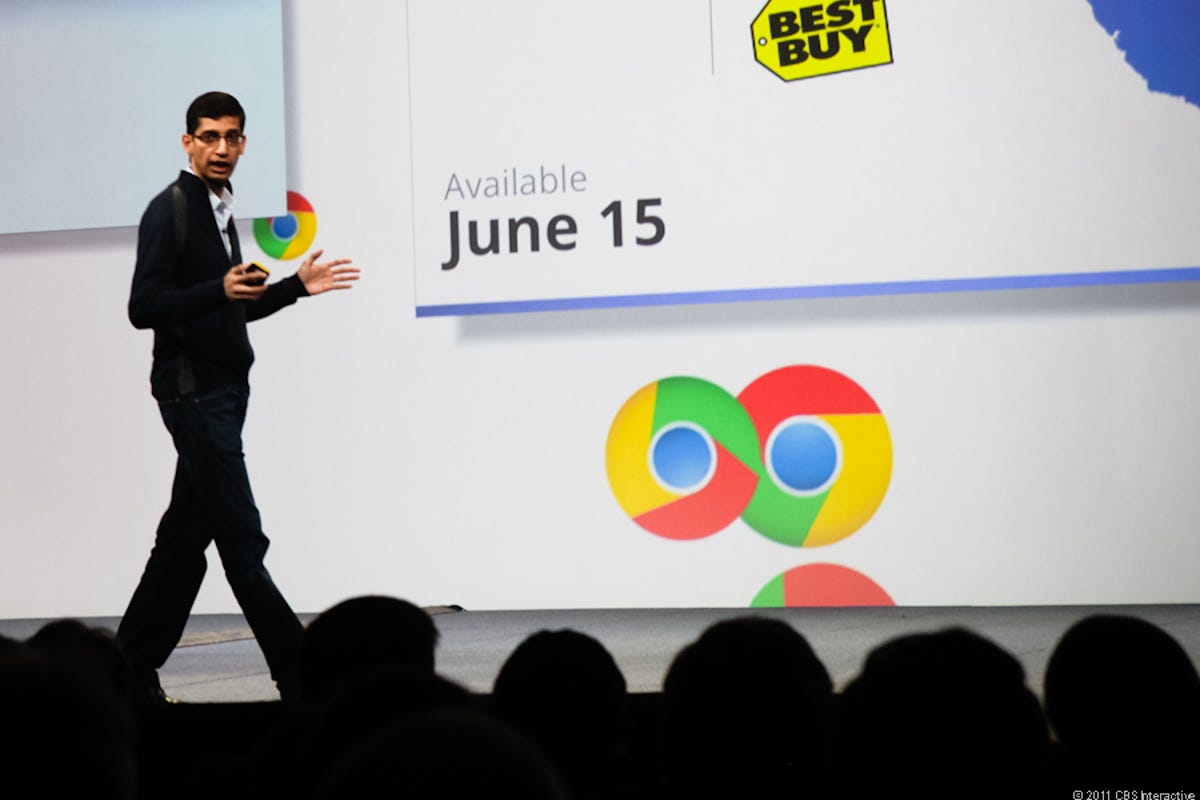
CNET/James Martin
SAN FRANCISCO–The second day of Google’s annual Google I/O developer conference was all about Chrome.
Leading the charge on the news front was the announcement of the first Chromebooks, notebooks that are based on Google’s Chrome OS and provide an always-on and always-connected computing experience.
During the press conference following the keynote address on Wedneday, where the first two Chromebooks were introduced, Sundar Pichai, senior vice president of Chrome, emphasized that Chromebooks represent a new model of computing.
“It offers an end-to-end computing experience,” he said. “It’s very different from a (Microsoft) Windows machine. The always-connected and always-on capability of it offers a totally different experience.”
Samsung and Acer will each be offering Chromebook notebooks starting June 15. The Samsung Chromebook will cost $429 in the U.S. for the Wi-Fi only version and $499 for the 3G version. Acer’s Wi-Fi only Chromebook will cost $349.The devices will be available for sale in the U.S. from Amazon and Best Buy.
Google will also be selling these Chromebooks internationally in the U.K., France, Germany, Spain, the Netherlands, and Italy.
Though the Chromebooks look as if they’re pitted against inexpensive Netbooks and even possibly new tablet PCs, the pricing seems expensive given that the devices leverage only Web apps from Google’s cloud services. No real software is running on the devices.
As a result, the relatively high price tag for the first Chromebooks has come under fire from some critics.
“It’s pretty interesting,” said Michael Gartenberg, an analyst with Gartner. “But at these prices, will consumers buy it? At $499, that gets you a pretty capable Netbook or even an iPad.”
The initial Chromebooks are priced similarly to other Netbooks with more functionality, as well as to tablet PCs. But Google’s Pichai defended the pricing, saying during the press conference that it’s fair, considering the quality components that are in these initial models.
“A good display and processor will cost you about $150 per device,” he said during the Q&A with reporters. “And then you have the good trackpads and other quality components. These aren’t meant to be cheap computers. They’re meant to offer a great experience.”
Google co-founder Sergey Brin chimed in during the press conference with his own thoughts on pricing. He took an informal poll by a show of hands among journalists in the audience to see how many people were using laptops that cost less than $500. Only one person raised her hand, while the majority said their laptops cost more than $800 or $1,000.
“The One Laptop per Child initiative has been super successful,” he said. “It may not have been exactly what (Nicholas) Negroponte had hoped for. But it has driven components down in price. So Chromebooks may not be $100, but they’re pretty cheap.”
Related links
Google also unveiled a subscription program for businesses and schools to get Chromebooks. For businesses the cost is $28 per machine per month. And for schools, the cost is $20 per machine per month. The subscription fee includes the hardware, administrative support, hardware upgrades, and warranty.
Chromebook laptops weren’t the only big news to come out of the morning keynote presentation. Google also made several other notable announcements:
- The Chrome browser now has 160 million active users. In the past year, Chrome has more than doubled its user base, growing from 70 million active users in 2010 to 160 million users this year. Google has also switched to a six-week release cycle to get features to Web developers sooner. This week, Chrome 12 entered beta.
- The Chrome Web Store has also been expanding and is now available in 41 languages along with several more countries.
- Google detailed its in-app payment system for Chrome Web Apps. It’s giving developers easy tools to develop the payments, and it’s also allowing developers to keep 95 percent of the sale price of their apps. Google is taking only a 5 percent cut.
- The popular mobile game Angry Birds, by Rovio, is also coming to the Chrome Web Store, as it makes its debut as a Web game.
For a blow-by-blow recap of Wednesday’s keynote presentation, check out CNET’s archived live blog.



